SteamWorld Build is a management simulator that divides my attention between a boom town on a desert surface and the mines underneath it which feed the town’s prosperity. Both halves emphasize different kinds of game design. The surface is an ordinary city simulator where I build homes for the town’s SteamBot citizens, amenities to keep them healthy and entertained, and infrastructure to keep it all connected and functioning. The mines emphasize resource gathering and, as the SteamBots delve deeper, tower defense segments. My time spent there is more like a simplified real-time strategy videogame.
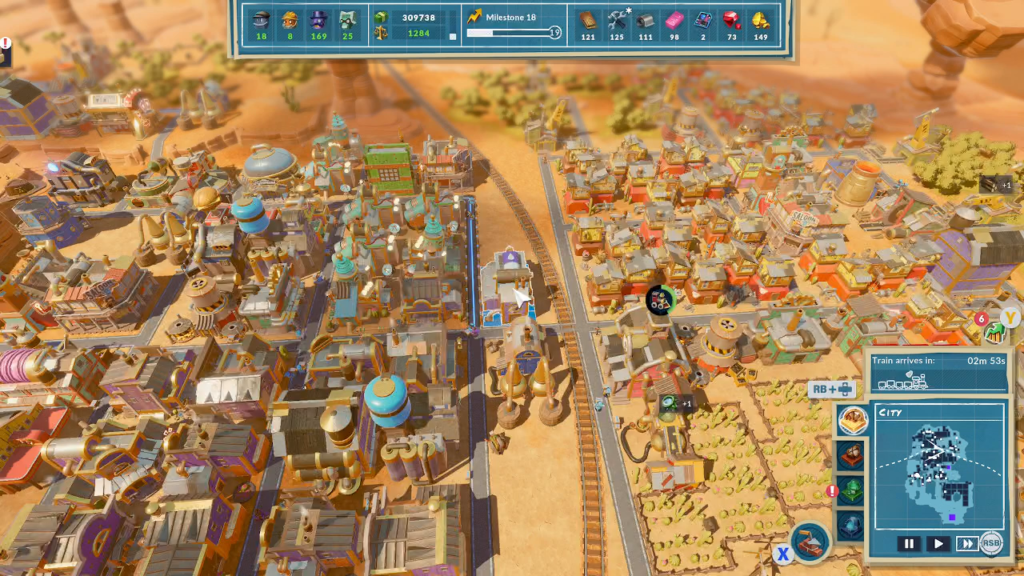
Build’s ultimate goal isn’t to create the largest or richest town. It is to find the parts of a disassembled rocket from an ancient civilization that are buried in the mine. Once all the rocket’s parts are found and reassembled on the surface, the SteamBots of the thriving town will use it to leave the planet and find a new home somewhere among the stars.
Before I found a new town I am given the option to toggle Build’s story elements on and off. I understand why this option exists. City management simulators emphasize replayability and sitting through narratively-driven cutscenes I’ve already seen can become tedious. For my first time playing I opt to leave the story elements on.
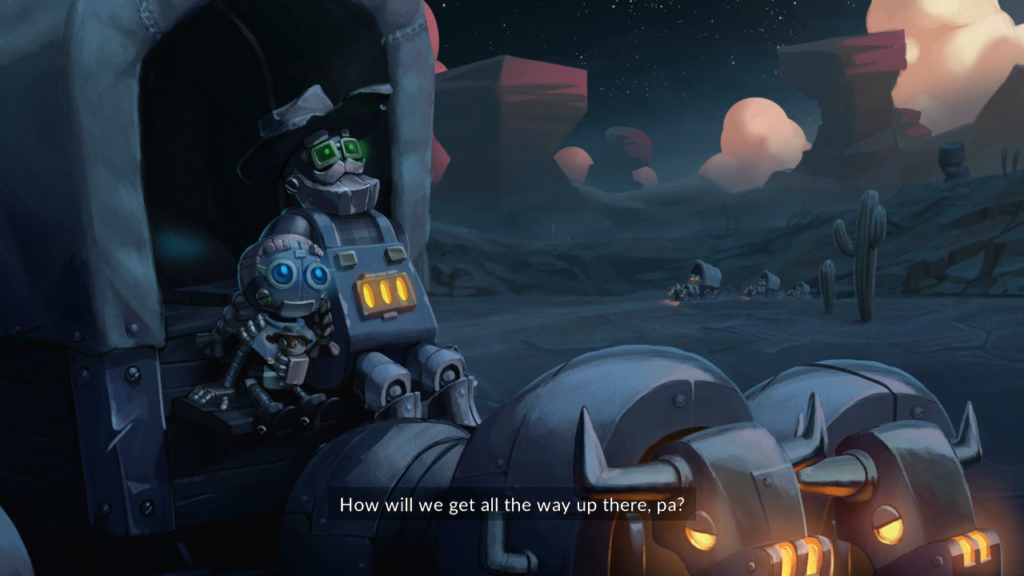
The opening cutscene introduces me to the SteamBots Jack Clutchsprocket and his daughter Astrid. The pair ride through a desert at the head of a wagon train late at night. Jack points to the stars and tells Astrid they will live there once they escape their world. Why they need to escape goes unexplained, but I know who’s put them up to it: Core, a damaged robot they carry in their wagon who tasks them with recovering and rebuilding the rocket.
Thanks to my previous experience with SteamWorld videogames, I recognize Core as one of the malevolent Vectron VoltBots who regularly menace the SteamBots. Even without this knowledge, I would know that Core is up to no good thanks to his blatant villainous coding. He has a vaguely Transylvanian accent, his eye glows an eerie purple which contrasts the SteamBot’s friendly blue and green, and he makes a haughty remark that SteamBots excel at manual labor.
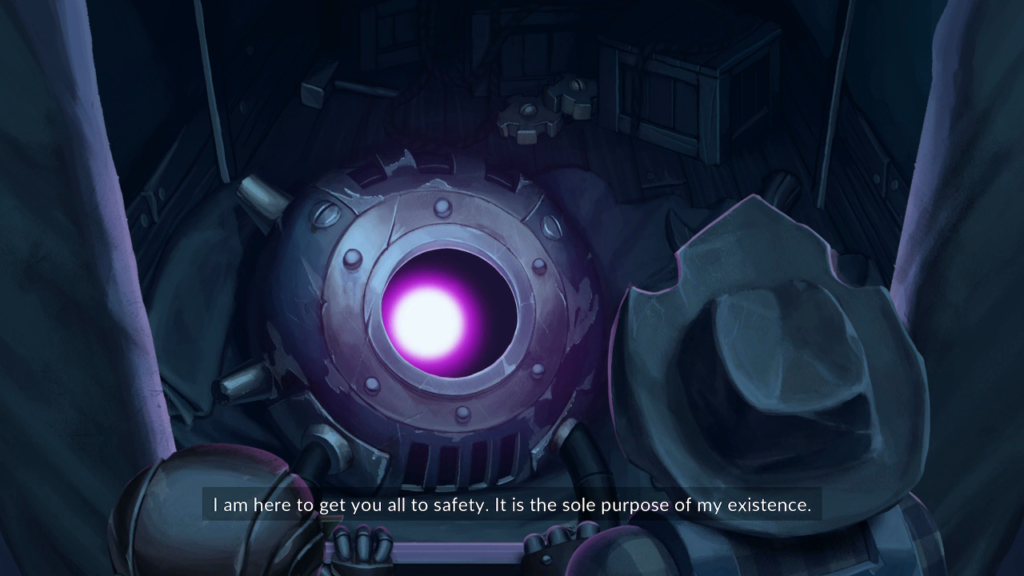
Jack, Astrid, Core, and a few other SteamBots pop up at key milestones to have brief conversations about their progress and the objects discovered in the mines. Even if I were about to enter my tenth new town, I would not find these interludes all that intrusive. They are short and may be clicked through quickly. None of the featured characters are particularly memorable. It’s all a shame, since character design and writing are elements in which previous SteamWorld installments have excelled.
Another issue created by this brevity is a muddying of where Build lies in the ongoing SteamWorld narrative. Dig 2 also ends with the SteamBots escaping their planet to space, leading to the events of Heist. It’s not at all clear that Build happens concurrently with that exodus and its ending suggests a quite different possibility. Perhaps this lack of clarity is ultimately a good thing. It precludes new players becoming lost in continuity. I don’t feel like I am required to have played any of the previous SteamWorld videogames to understand what is happening here. As someone who has played those previous entries, their lack of significance to Build’s narrative feels disappointing.
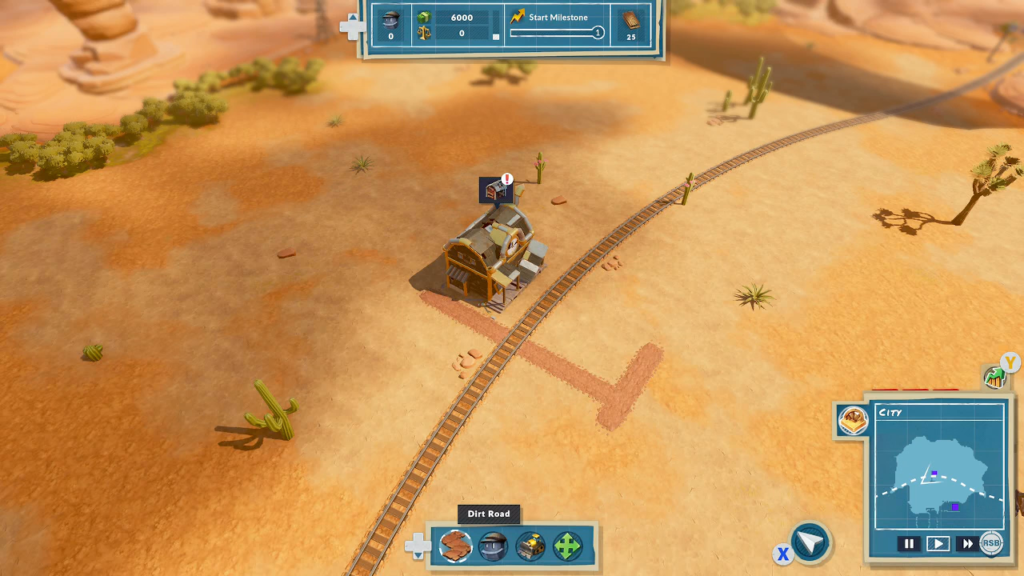
When I arrive on a fresh map, I see an empty desert cut by a railway track. Nearby are a disheveled train station and a broken mine shaft. From this empty patch I construct a town that will help the SteamBots escape into the stars.
The fundamental elements of my town are its SteamBot citizens. They are divided into four groups: Workers, Engineers, Aristobots, and Scientists, each possessing different skills which support the town and the mine. The more of each group my town can support, the more tools and technological upgrades they can access which aid in retrieving the rocket parts and reassembling them on the town’s outskirts. Concurrently, the more of each group the town supports, the more difficult it is to satisfy all their demands and keep the town operating.
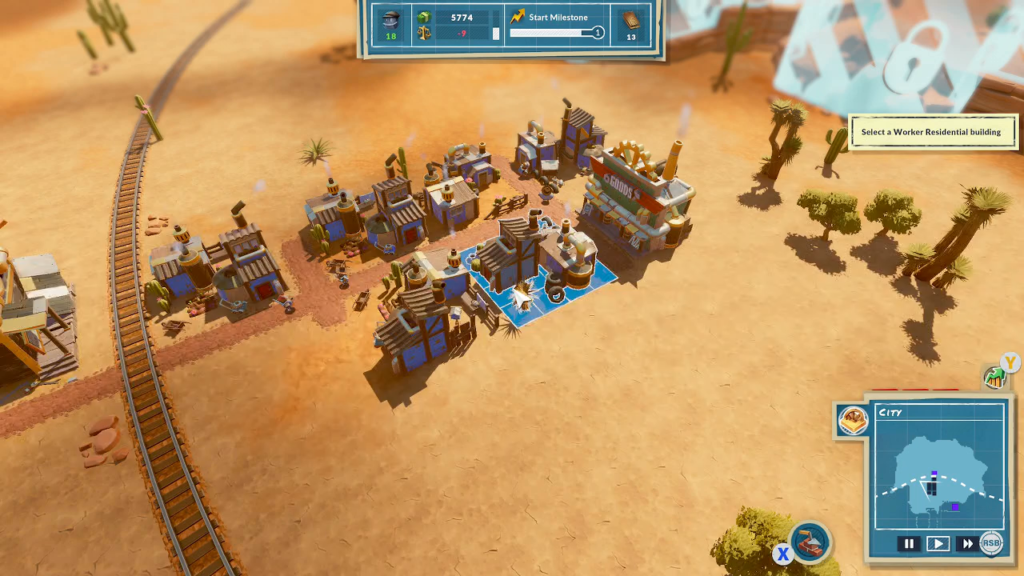
When I establish a new town I only have access to Worker SteamBots. They are the simplest group to support and correspondingly provide the least benefits to the town. Workers do not appear until I build a small residential unit somewhere on the map adjacent to a dirt road which connects to the train station. I quickly build a cluster of Worker Residential units across the tracks opposite the train station.
When a new Residential unit is built, only a few SteamBots will move in. To maximize the number living in a unit, I must satisfy the unit’s needs. Workers require a General Store and a Service Shop near them; if I select one of these service buildings with the cursor, I can see how far their influence reaches on my road network. As my town needs more and more Workers to achieve the next technological milestone, I will need to build more General Stores and Service Shops as the Worker Residential units sprawl beyond the reach of my first pair.
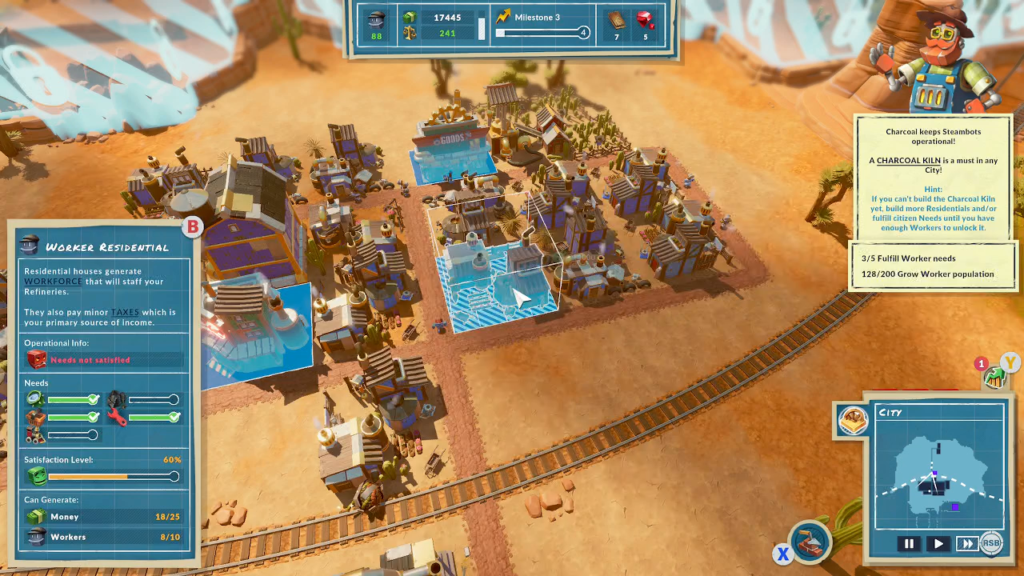
It is in this SteamBot satisfaction element that Build most fumbles its interface. In the Xbox version I played I could find no comprehensive way to view residential units containing unsatisfied SteamBots. There is no overview screen breaking down the total number of citizens and the ratio of satisfied to unsatisfied ones. If there’s general discontent, then red sad faces appear above every affected unit, though this only happens if I’ve really let things get out of control. If I want to be sure every unit is fully satisfied, I have to select each one, one-by-one, and look at its meter in a box at the bottom-left corner of the screen. The solution I find is to build a single residential unit and not build another until the most recent one is fully satisfied. This works in the short term, but is not practical in the long term as my town begins to transform.
As this is my first time playing Build and I am inexperienced with city management simulators in general, I play with the tutorial activated. It does a good job walking me through the early parts of founding my town but its advice becomes infrequent as the town grows. By the time it becomes completely silent, I don’t even notice its absence. Early on, when it still holds my hand through every step, it teaches me to construct a Forester where Workers can harvest logs, a Lumber Mill where they cut logs into lumber, and a Warehouse where logs, lumber, and every other kind of resource the town will eventually use are distributed around town. Lumber is needed to add Engineer citizens to the town who are key to accessing the mine.
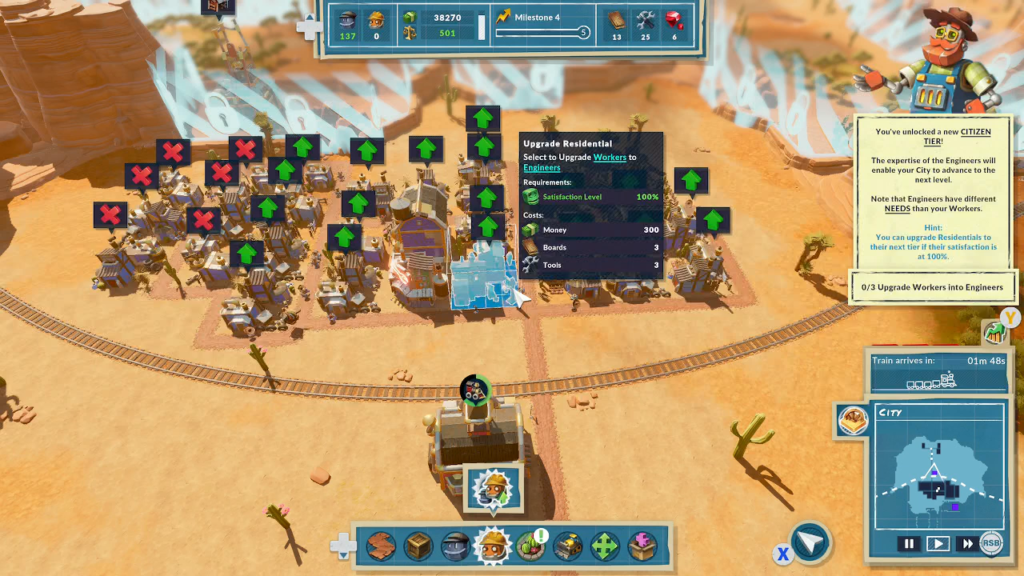
Like Workers, Engineers live in their own Residential units which must be connected both to the train station and to buildings which provide the services that keep them satisfied. The complication comes in that I cannot build their units independently. Instead they must be upgraded from an existing Workers Residential unit.
This upgrade process necessitates constantly bringing in new citizens. The town balloons outwards with new Workers Residential units as I upgrade the old Workers’ units into Engineers’ units. When those Engineers’ units are later upgraded to Aristobots, then the replacement Workers’ units become replacement Engineers’, and a new set of Workers’ units must be built to keep the town functioning.
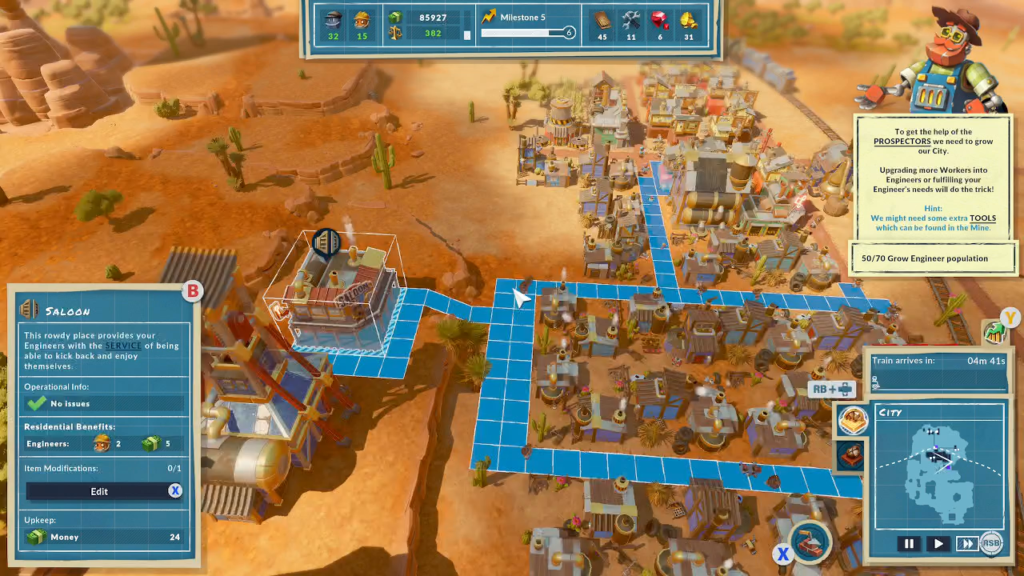
New Engineer citizens further complicate my town because they require more service buildings to satisfy them. Workers are satisfied by a General Store, a Service Station, and a few amenities like coal and fresh water. Engineers demand no less than ten different services and amenities to be fully satisfied, and only one of them overlaps with the Workers. Build luckily allows me to relocate any building anywhere I want at no charge with a Move tool, preventing ugly situations like bulldozing some Workers’ homes to make room for a Saloon the Engineers need nearby to be happy.
Adding Engineer citizens to my town gives me a few useful new options. A mundane but impactful one is the ability to build paved roads instead of the dirt ones I have been using. It costs a little extra money, but paved roads cause the influence of service buildings to travel further, ensuring fewer buildings can satisfy greater numbers of Residential units. Worker SteamBots also carry resources around the town faster when walking on a paved road. The more important change Engineers bring to town is they can repair the mineshaft so the SteamBots may begin exploring the mine.
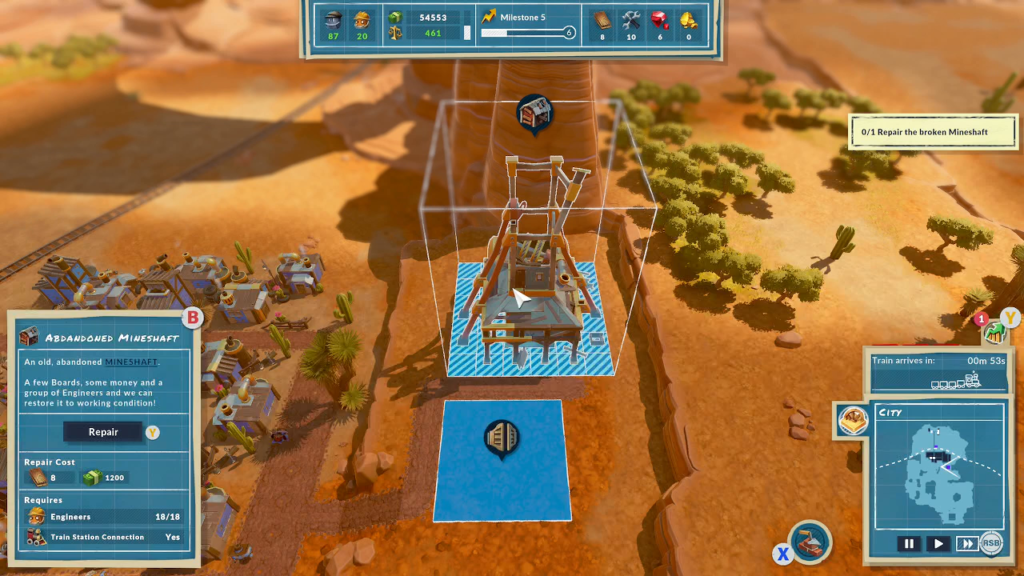
The Mine consists of three levels and Build does a good job easing me into them. The first level, the Dusty Caverns, is the simplest, giving me a chance to learn how the mine differs from the town.
My first view of the Dusty Caverns shows me that the mines look quite different from the surface town. It is depicted on a grid filled with cubes made of dirt and rocks. Some cubes contain precious metals. Others contain old machine parts. To break down these cubes, I must build Quarters to support Miner SteamBots. The more Quarters I build, the more Miners will work in the mines. I can direct them to clear any dirt cube by highlighting it with the Dig tool from the toolbar. From there, I can move on to other business. Miners will come along and break down the highlighted cubes automatically without any further direction. A squad of SteamBot Miners will clear away most of the mineable walls in the Dusty Caverns to find the hidden rocket parts.
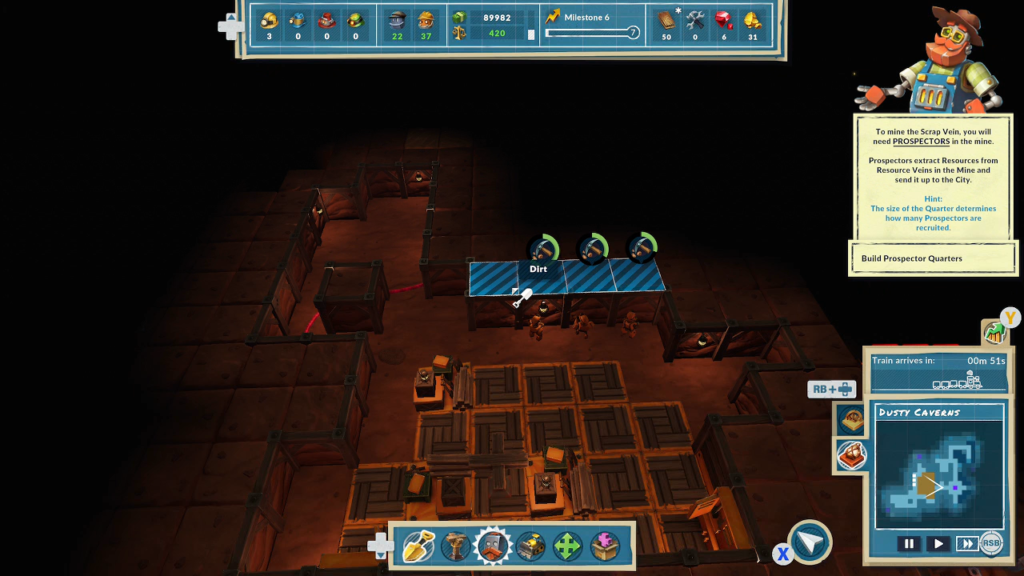
During the search for the rocket parts, many other useful things are found. Gold and scrap caught in the walls are automatically added to my inventory when the cubes containing them are destroyed. Bottomless sources of iron, water, oil, and many other natural resources can be collected and carried up to town by Prospectors. Like Miners, Prospectors need their own Quarters built on the mine floor. Gathering these resources by hand is inefficient, but Prospectors’ jobs can be made easier by Engineers who build and maintain machinery that gathers and packages the resources automatically. Engineers also require their own Quarters. As the Miners clear away dirt cubes, the extra space created is soon filled by dozens and dozens of Quarters for different kinds of SteamBots. Within an hour of entering the Dusty Caverns, its cramped spaces are dug away and developed into a teeming warren with dozens of SteamBot laborers scurrying in every direction, pursuing their specialized tasks.
Finally, after exploring most of the Dusty Caverns, the SteamBots find two parts to the rocket and another mine shaft that leads to a second level, the Marshy Ruins. Exploring here is much the same as it was in the Dusty Caverns, but adds a new wrinkle: Hostile monsters boxed into the walls who will attack SteamBots when the cubes around them are dug away.
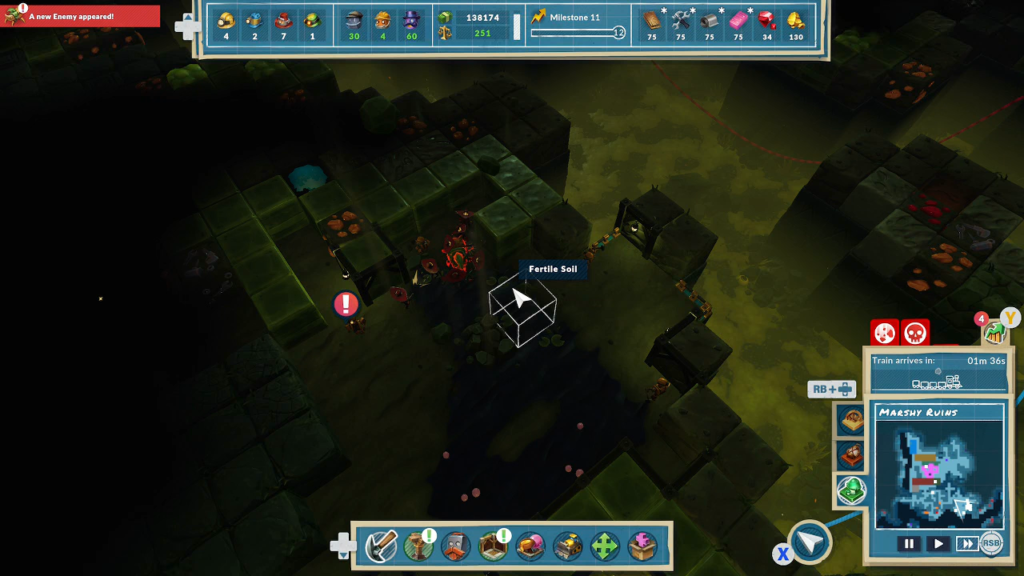
Monsters in the mines are dealt with by a fourth SteamBot category, the Guards. Like the other three jobs, Guards perform their jobs automatically, charging across the mine floor to attack hostile enemies as soon as they appear. For the most part, this is satisfying. I know as long as I’ve built enough Guard Quarters that I don’t have to pay too much attention to attacking monsters uncovered through mining.
Monsters are more of a concern when the Miners uncover a Hive. These hot spots produce large numbers of monsters every few minutes near important resources—such as near a buried rocket part. As more of the Marshy Ruins are revealed, multiple hives are uncovered which are more than happy to unleash their waves simultaneously. These are the times when I would prefer to focus the Guards’ attention in one area, but I am never given control over them at that granular level. They always decide for themselves where they are most needed.
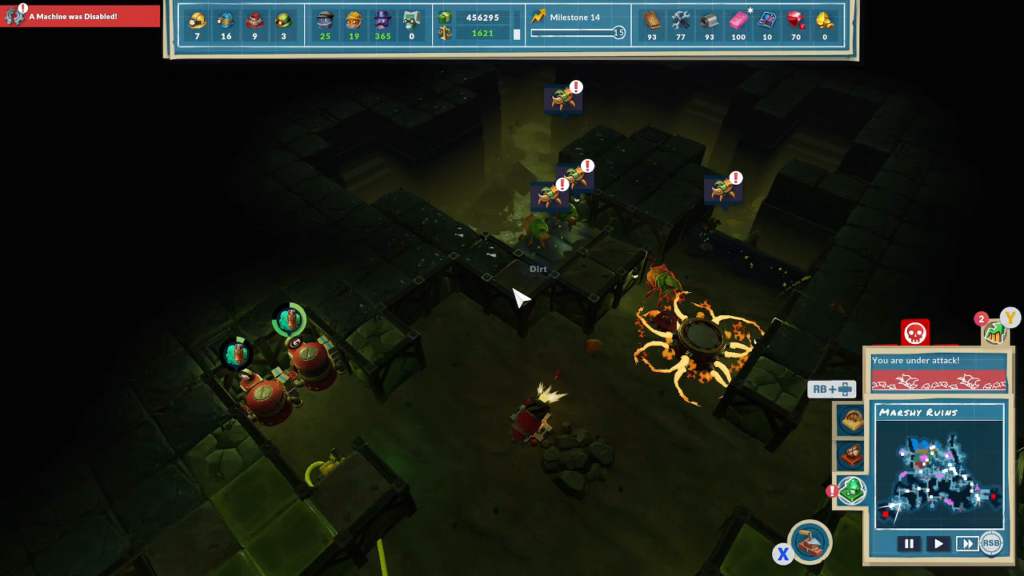
The solution to these regular hive attacks is not to rely on the Guards. Instead, the SteamBot Engineers can build defensive machines to repel attacks from the hives. Building a line of columns that spew flames, turrets that launch grenades, and cannons that spit lightning can also repel a Hive wave. Built with enough density and Engineers to keep them repaired, defensive machines can leave Guards free to defend SteamBots who uncover enemies sealed in the mine walls.
Once I’ve fortified the SteamBots’ presence in the Marshy Ruins, I’ve seen just about everything Build has to offer. There is a third level to the mine, the Crackling Depths, but the challenges faced there are almost the same as those found in the Marshy Ruins. The main difference is there are more Hives to keep under control and a new type of enemy.
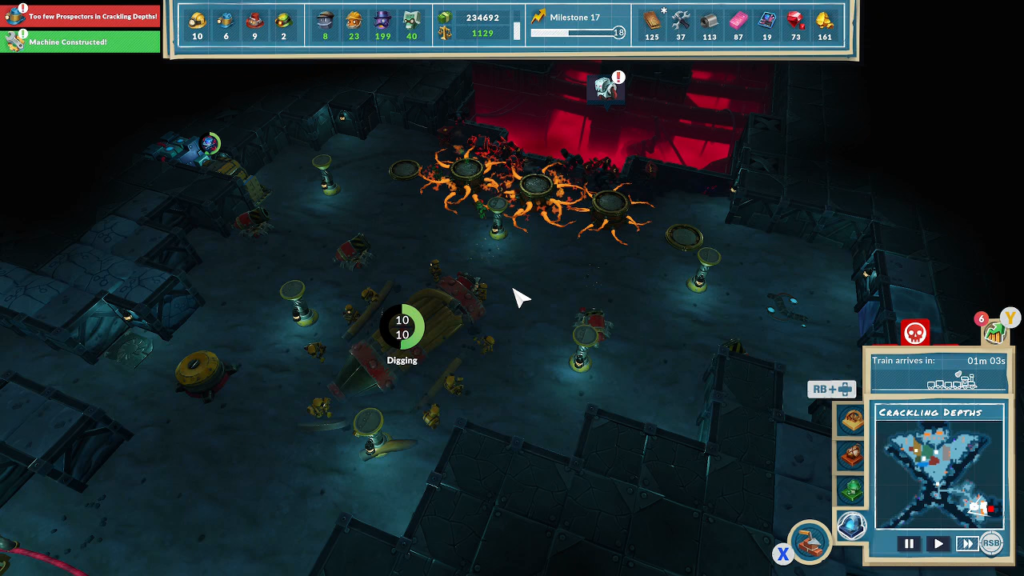
The most impressive thing about Build’s design is the town and all three levels of the mine operate continuously and simultaneously. What keeps this from becoming overwhelming is all four areas do a good job of running themselves while I focus on events elsewhere. There are no natural disasters or other events that demand my immediate attention in the town. The SteamBots in the mines are highly automated. I may forget the Dusty Caverns exist once I’ve fully explored all its corners. I receive regular warnings about Hive attacks in the Marshy Ruins and Crackling Depths, but a strong line of defensive machines and enough Engineers and Guards to back them up means I can mostly ignore these warnings. As a result of this ultra-moderation, it is quite easy to become complacent and inattentive to some corners of the town and mine.
This complacency is where I encounter the one moment I struggle in Build. It’s several hours into my first town and not once have I been unable to build anything I might need at any moment. Everything is constructed with so little friction that it’s been hours since I’ve even glanced at the omnipresent bar on the screen’s top which shows the town’s total funds and the income that comes in multiple times a minute. It’s midway through the Marshy Ruins when it finally happens. I try to convert a plot of fertile soil into a mushroom farm, and I receive a notification: There is not enough money to do that.
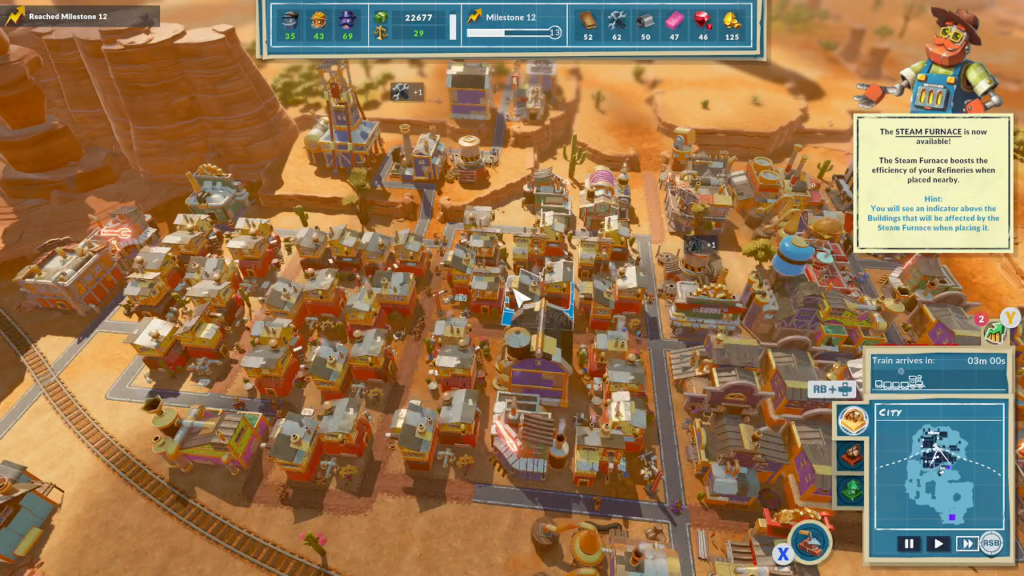
This is the moment I realize I must learn how Build’s economy actually works. Until this point I have had an understanding of how to keep the SteamBots satisfied, but not how their satisfaction correlates to income for the town. Luckily Build is a simplified city management simulation, so the solution turns out to be correspondingly uncomplicated.
My assumption early on is the town needs a balance of all different kinds of SteamBots. This assumption is my folly. The disparity between taxes generated by the four different tiers of SteamBot citizens is comical. Instead of a balance, I need just enough of the bottommost tiers to keep their resources moving, and as many of the current highest tier as I can cram into the map’s limited space. This maximizes the town’s income, ensuring there are always funds available when I need them. In order to succeed in the Marshy Ruins, the town needs to accommodate as many Aristobots as possible.
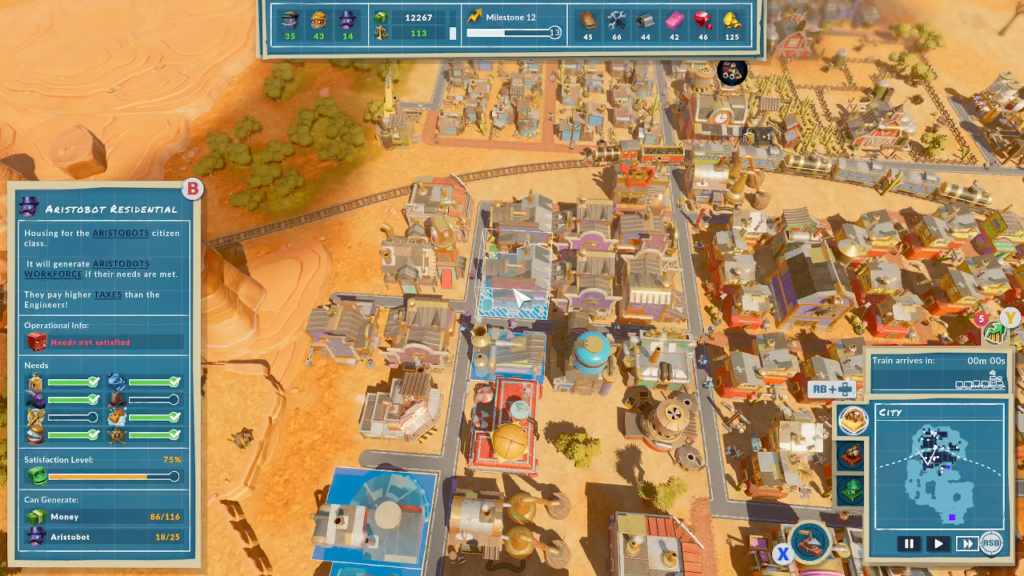
The tricky spot with this plan is that I have little reserve funds and almost no income. This forces me to wait several minutes at a time for the town’s limited tax revenue to provide enough money to upgrade an Engineers’ Residential unit into an Aristobots’, and then to replace those lost Engineers, and then to replace those lost Workers. I run into still more revenue problems satisfying the Aristobots’ numerous and genteel requirements. It takes a few hours and a bit of shuffling around the town’s configuration with the Move tool, but I soon develop the town’s tax base high enough that several thousand dollars are added to its total funds every few seconds. I can once again build willy-nilly without paying attention to my fund total.
It is in building all these new buildings for the Aristobots that I must return to Build’s console interface. Each category of building is organized in a menu at the screen’s bottom, divided under the type of citizen it supports. The General Store and the Service Shop are under the Workers submenu, the Moonshiner and Saloon are under the Engineers submenu, and so on. This makes logical sense. Where this system breaks down is when I need to increase production on specific kinds of resources citizens need to be fully satisfied.
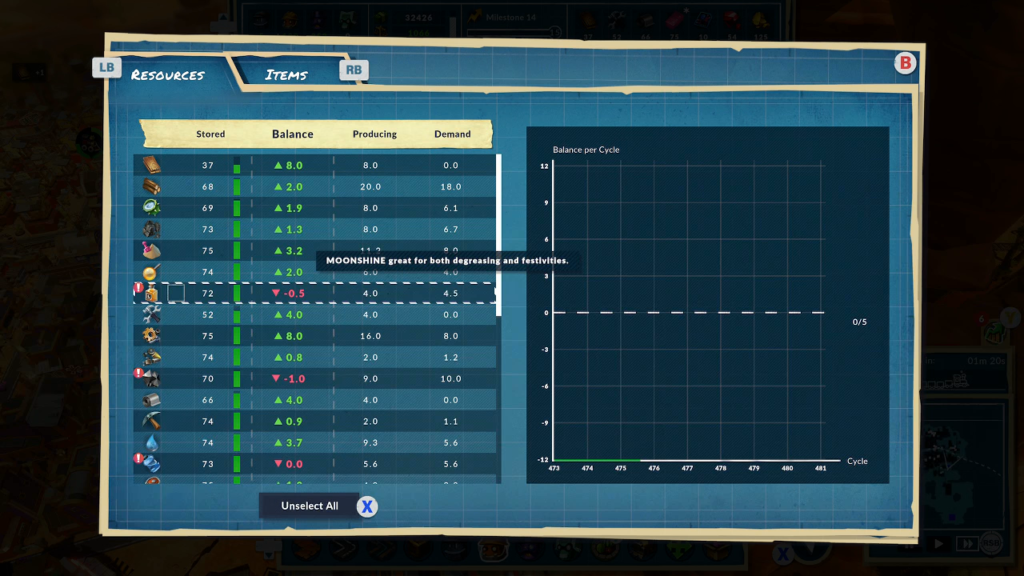
While there is no detailed menu which tracks citizen satisfaction, there is a detailed menu on which resources the town is producing and the rate at which they are being used. Arrows give me simple information I can recognize at a glance. When everything is green and pointing up, then the town is producing resources faster than it uses them. If anything is red and pointing down, then that resource is being used faster than it is being produced and one of my citizen groups will soon be deprived of one of their needs, become unsatisfied, and leave the town. If this happens to the Workers or the Engineers, the subsequent depopulation can cascade to the other citizen groups, spelling disaster for the town’s income.
To keep my Engineers happy, they need a nearby Moonshiner. For the Moonshiner to function, they need glass bottles from a Glassblower and the Glassblower needs glass from a Sand Sifting Factory. The Glassblower and the Sand Sifting Factory are further subdivided under the Moonshiner icon in the Engineer submenu. If my resource page ever reports a shortage of bottles or glass, I need to remember that those buildings are hidden under the Moonshiner submenu which is hidden under the Engineer submenu.
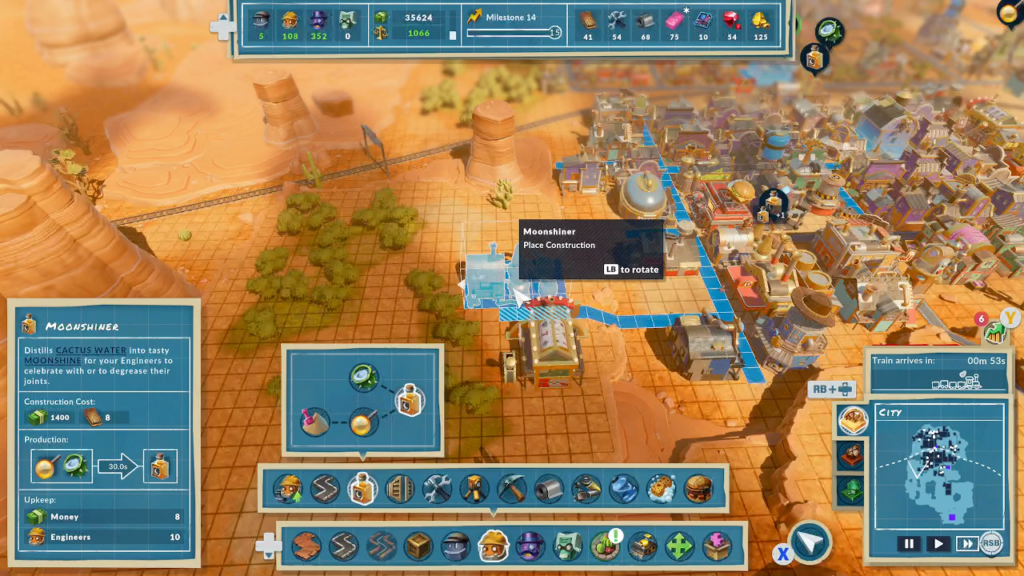
This is a lot of submenus to keep track of and the number of production facilities sequestered within them grows exponentially as the town adds Aristobot and Scientist citizens. The only thing that prevents this from being a serious impediment to success is I can freeze time whenever I want, letting me take as long as I need to poke through voluminous submenus without the town’s economy further breaking down. I appreciate the difficulties of adapting a city management simulator, traditionally the realm of a keyboard-and-mouse interface, to a standard controller, but I still find myself questioning if there isn’t a better way.
With the town’s economy stabilized and improved, I vow not to get so wrapped up in the mines that I ignore its growth again. The rest of my time is smooth sailing to the remaining hidden rocket parts.
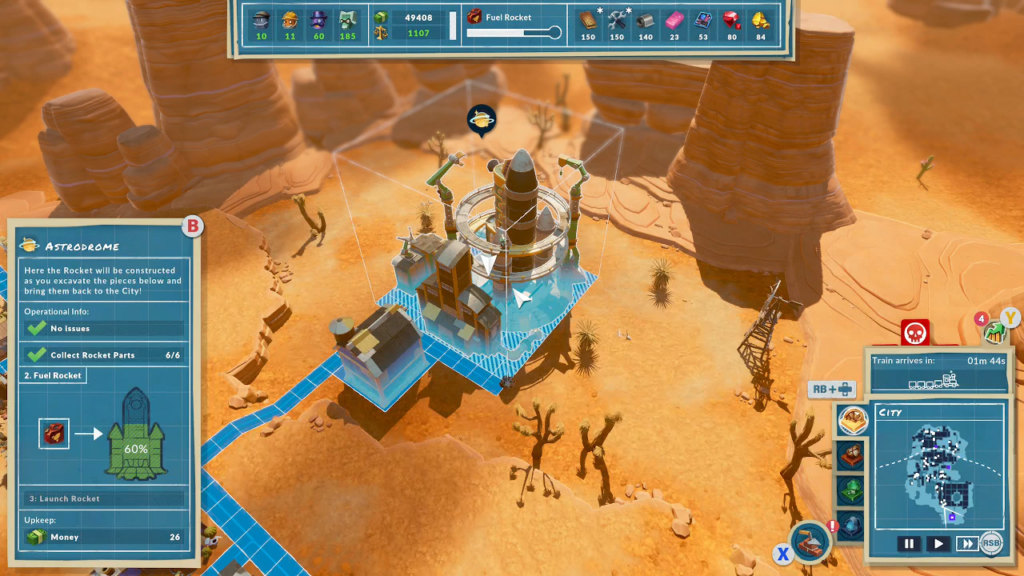
Build doesn’t quite end when the SteamBots have recovered all the rocket parts and assembled them back on the surface. There is a brief endgame period where the rocket must also be fueled. Fueling it requires a special material only found in the mines and a few new production buildings in town.
I am underwhelmed by this phase. It doesn’t add anything new. Recovering resources from the mine and developing them in town is mundane to me by this point. The Hives continue their assaults, but they do not grow in size or intensity—at least, not at a level I notice. This stage is essentially another half hour of waiting before the rocket launches and the campaign properly ends. It is the only point in Build where I feel like I am doing nothing. I would like to see it revisited in a future patch to give a more interesting and challenging wrinkle to what has become a familiar process.
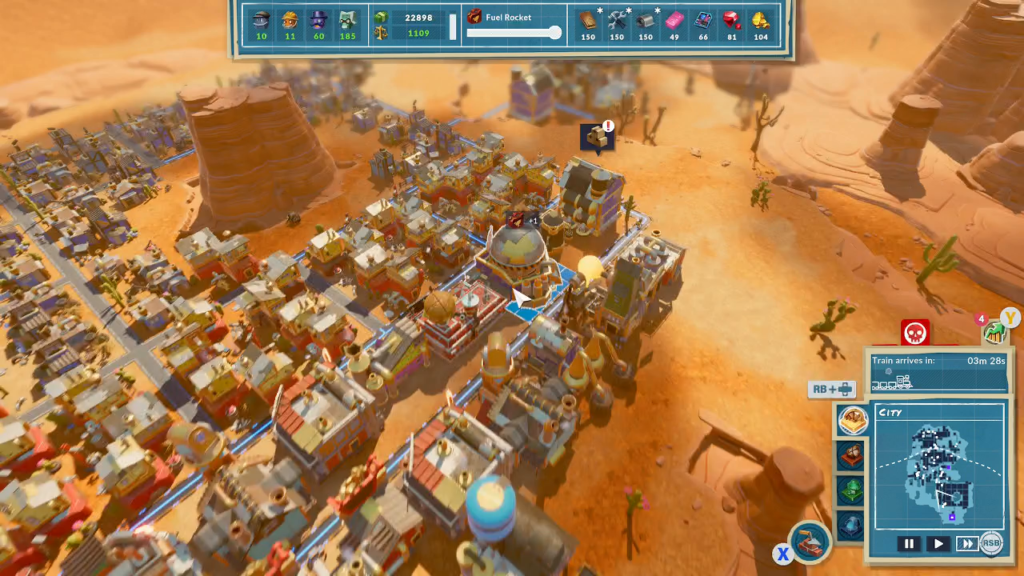
This is only my first town and the SteamBots’ first escape on the rocket. SteamWorld Build provides many reasons to keep playing. When I begin a new town, I am presented with five different destinations where the town may be built. I opt for the first option, Giddyup Gorge, for my first time playing. Other options include Tumbleton, the town from SteamWorld Dig, the Las Vegas-inspired Highroller Dunes, and a place strewn with sun-bleached dinosaur bones called Fossil Park.
Each map has unique geography which creates their own challenges for town layouts. Every new town, regardless of the map it is played on, also produces a new randomly generated mine. Completing each map also unlocks a special perk which can be used in future towns; for completing the rocket in Highroller Dunes, all roads in future towns may be built for free, which is a huge moneysaver. It takes me a little over ten hours to finish the Giddyup Gorge scenario, so I estimate Build provides at least fifty hours of play to see everything it has to offer.
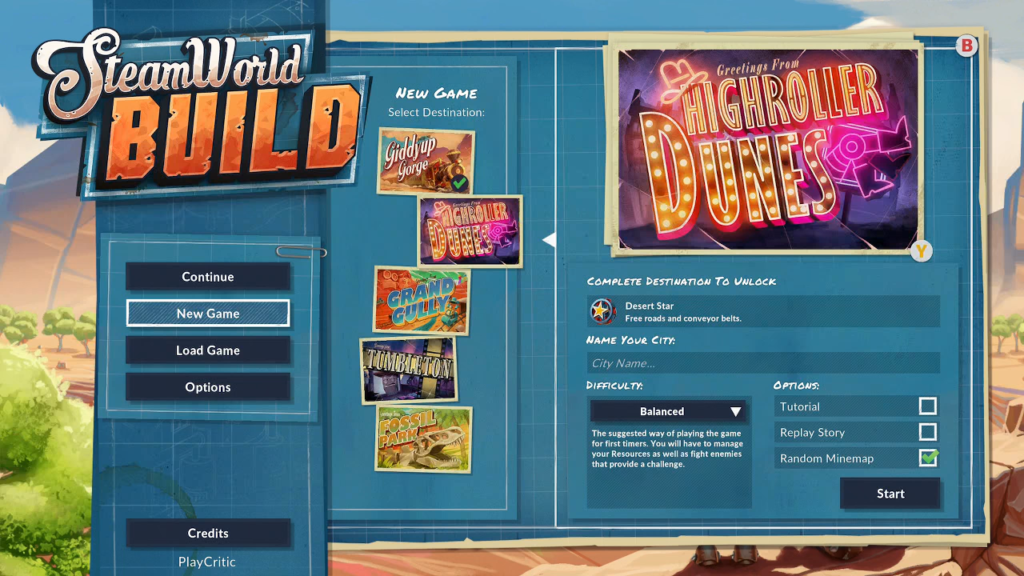
I describe my experience with Build as frictionless, but I also play on the default Balanced difficulty. There are easier “Casual” and harder “Difficult” options available. If my experience developing the town’s economy sounds miserable, the Casual difficulty will preclude it from happening. If my experience sounds too easy, then Difficult drains the mine of most of its resources, forcing the player to play slower and more thoughtfully. There is also a fourth “Sandbox” difficulty that removes the rocket parts and lets me develop a town into infinity. I can’t imagine why I would want to do this.
The particular strength of the SteamWorld series is changing its identity from entry to entry, exploring genres as disparate as tower defense, non-linear platformers, turn-based strategy, and card-based roleplaying videogames to further the story of the SteamBots and their clashes with the VoltBots. In terms of story and characterization, Build is the weakest entry so far. I’m not even sure where in the SteamWorld timeline it takes place. It may not take place on the timeline at all and is merely a videogame starring the SteamWorld SteamBots.
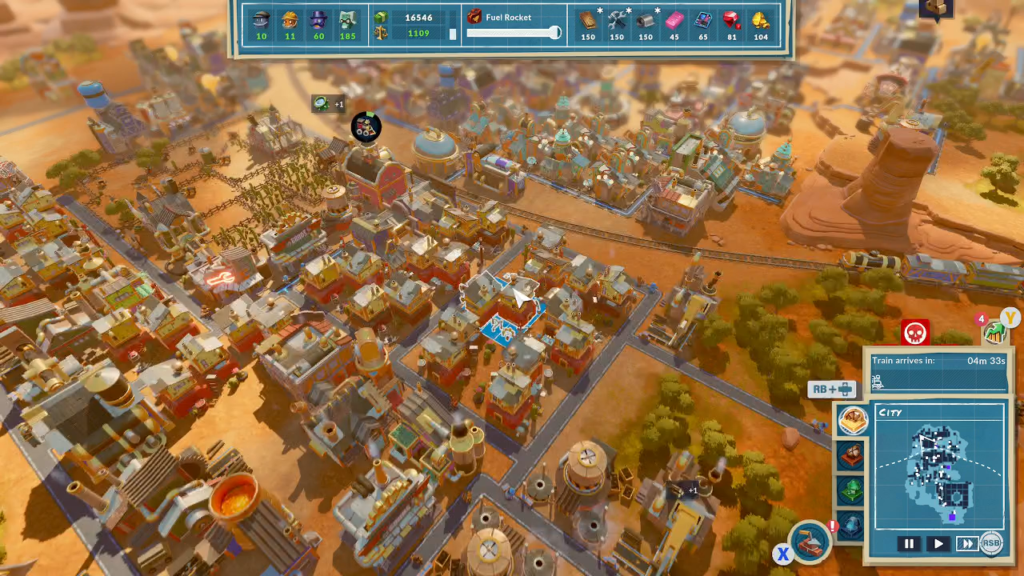
In terms of design and personal satisfaction, Build is one of the series’ most successful installments. It not only brings a new and wholly unexpected experience to the series, it also succeeds at combining multiple genres into a single package with hardly a seam to be found. My brief forays into other city management simulations have not been successful. SteamWorld Build feels like an excellent introduction to the genre, and I recommend it to anyone who, like me, has struggled with them in the past.